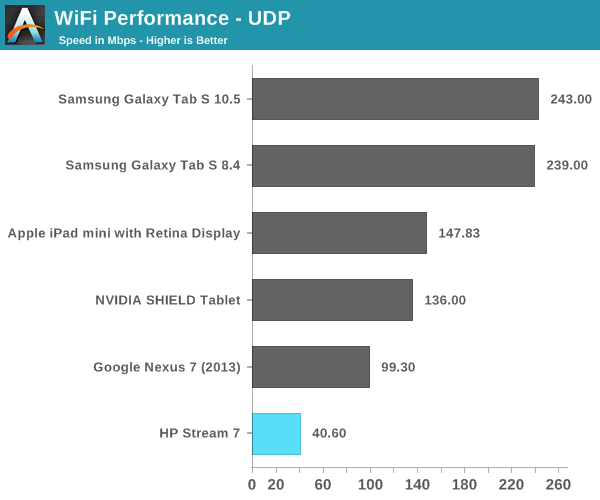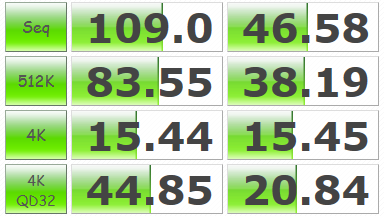HP Stream 7 Review: A $119 Windows Tablet
by Brandon Chester on December 19, 2014 8:00 AM ESTCamera
It looks like including a camera is now a requirement for pretty much any device, and so even the Stream 7 has a front-facing and a rear-facing camera. In the Windows device manager, the front camera identifies itself as "Camera Sensor GC310". I haven't been able to find any information about it, but the image quality leads me to believe that it may be best for people to not know where it came from. The rear camera idenitifes itself as HM2056, which I was able to find information about. It's made by a company called Himax Imaging, and if you haven't heard of them it's okay, because I hadn't either. It's a 2MP 1/5" sensor, which translates to 1.75 micron pixels. It has no auto focus, and that combined with the specifications leads me to believe that this is normally intended to be a front-facing sensor.
As you can see, the output is really bad. The text on the back of the books is illegible, most detail is lost, and there's noise everywhere. It's just honestly not a good camera, and it's something I would only use as a last resort. It's somewhat annoying that HP felt the need to even put a rear camera on the Stream 7, as it adds to the BOM and the money could have been better used on something like a larger battery.
NAND
I mentioned earlier that the Stream 7 doesn't even have enough storage to fit PCMark 8 and some of the other benchmarks we use. Out of the box, you get around 18.5GB free. This means that we can't run our typical Windows storage benchmarks, so I've used CrystalDiskMark to get an idea of how the storage performs.
I wouldn't try making direct comparisons between this and our storage benchmarks on Android and iOS, but it's still able to give you an idea of what you can expect. The Stream 7 uses Samsung's MGB4GC eMMC solution, so we can't expect the same storage performance that you get from Windows devices with a full blown SSD. The read and write performance ends up being pretty good for an eMMC solution, although I'm suspicious of the 4k random write result considering how even the best eMMC solutions we've seen in Android and iOS tablets top out around 3MB/s.
WiFi
The HP Stream 7 uses a Realtek RTL8723BS solution for WiFi and Bluetooth. This is a single spatial stream 802.11n part, with no 5GHz support and only 20MHz channel width. That means that we're dealing with a theoretical maximum speed of 72Mbps. In real world use, it's quite a bit less, as you can see below.

Again, at $119 this is expected and can be excused. Faster WiFi would be nicer, but it's not free. My only complaint about this speed in the real world is that the slow WiFi makes it difficult to move large files over the network onto the Stream 7. This wouldn't be an issue if these Windows tablets allowed you to directly move files to them from another computer over USB, but they don't. I've also encountered issues with the WiFi disconnecting intermittently, which is incredibly frustrating when it means you have to begin transferring a large video from the beginning. I've contacted HP about this to see if they're aware of this issue, as I've seen complaints about it from other users, but I haven't received a response.
Misc
I am unfortunately not equipped to do objective audio testing on the Stream 7. It uses Realtek's audio codec, and so it isn't likely to be anything exceptional. The bottom mono speaker is adequate; there's not much to be said about it. Unfortunately, everything comes crashing down when you try to use the 3.5mm jack. Even if the Stream 7 had the best audio solution in the world, it would be crippled by this defect that I cannot believe made it to production.
Essentially, the 3.5mm jack has a great deal of noise and static, and it makes it effectively unusable. I have confirmed this with two other owners, and there are complaints about it on the web. It's likely that there's an insufficient amount of shielding for the audio port and PCB connections, and it's extremely disappointing. With its support for all the great video players on Windows, the Stream 7 could have been an inexpensive and powerful video player. But unless you're going to use the built-in speaker or Bluetooth headphones/speakers, there's no way to listen to audio on this tablet. When I reached out to HP about the WiFi connection issues I also asked about this, but again I haven't received a response.


















157 Comments
View All Comments
rootheday3 - Saturday, December 20, 2014 - link
Brandon-You say on the Display page of the review:
"It should be noted that these measurements were achieved by disabling Intel's Display Power Saving Technology (DPST) feature, which causes dynamic brightness and contrast depending on the image displayed on the screen. While some other devices do this to some degree, DPST ended up reducing max brightness measurements by nearly 100nits, and the constantly changing brightness played havoc with measurements during analysis and calibration."
and also on the battery life page:
"It's likely that enabling Intel's DPST will improve these results, but all that really means is that dimming the display below our 200nits standard will improve battery life."
DPST shouldn't reduce overall brightness - the algorithm it uses is designed to detect dark scenes and change the panel gamma curve to let more light through while reducing the backlight intensity to match. If working properly this can save a lot of backlight power on scenes that have low luminance values and moderate contrast to start with (e.g. movie watching). Normally there should be no noticeable difference in overall brightness of the image (though there may be a second or two of visible modulation if the image suddenly changes from bright to dark or vice versa). If you are seeing drops of 100 or 200 nits brightness when DPST is active, something isn't right.
For what its worth, other devices use techniques (called CABC - content adaptive backlight control) that do the same things as DPST - they generally just don't give you control over it the way that Intel's control panel does.
Are you 100% confident that the visual issues and brightness issues you are describing are isolated to this device or to Intel DPST in general and that other mobile devices don't have similar dimming going on?
Any possibility thaty you are conflating DPST vs Automatic Display Brightness (ADB) based on ambient light sensor detected brightness variations in the room?
Backlight is a huge contributor to platform power in tablets and other very low power mobile devices -If you only disable DPST on Intel platforms but don't disable CABC on other platforms, your low battery life results are perhaps not fair...
Note also that the Intel control panel offers an aggressiveness slider for DPST - can you reduce the aggressiveness value and see if that makes it better visually?
Brandon Chester - Saturday, December 20, 2014 - link
Some other devices do it in the video test, but not in the web browsing test. You can see the brightness of the Stream 7 decrease when you load a very white web page, and it goes back up when you return to somewhere like the Start Screen. This doesn't happen on an iPad. You can see in our Asus UX21 review that DPST does reduce the brightness when showing an all white screen, so I don't think there's anything wrong with my statement that DPST was reducing max brightness in our test.Oh and no, it wasn't ADB, I disabled that right when I set up the tablet.
Laststop311 - Saturday, December 20, 2014 - link
Smaller battery than note 4 phone thats only 5.7" is worriesome. This tablet could of been really good if they just upped the ram to 3GB and upped the battery to 4000+mah. I think it would of sold more if they raised the price an extr 25 for the extra 2GB of ram and an extra 15 for the extra 1000mah of battery. Doesn;t a tablet like that for 159 sound a lot better than the current one for 119Laststop311 - Saturday, December 20, 2014 - link
Wouldn't mind seeing a 64GB option for 30-50 more as wellados_cz - Sunday, December 21, 2014 - link
They can't up the ram without changing the CPU which in turn would increase the price further more, the atom Z3735G is limited to maximum of 1GB of ram. But the ram is not problem on this device, I hard-set swap file to 2GB on my Linx 7 (same atom) and it runs just great.Roy2001 - Saturday, December 20, 2014 - link
I have stream 8, Intel Soc performs very well, but OS is not so good.andrewaggb - Sunday, December 21, 2014 - link
I have a 64gb miix 2 8" windows tablet. Picked it up used/cheap. It's pretty decent, but the quantity of windows updates are a bit ridiculous. The app selection is much different, but there's plenty of games and apps my kids like on it. My daughter probably prefers it to the ipad, my son definitely prefers the ipad.Desktop apps suck on it, they run fine, but the screen is too small in my opinion.
Performance wise I think it runs fine.
Battery life is ok, but not as good as an ipad.
I imagine the stream 7 is very similar. For $100 it's probably a great deal. You also get full flash support, which I use for some streaming applications.
spdfreak - Sunday, December 21, 2014 - link
I wonder if these are basically the same as the Winbook Tablets that MicroCenter sells. The MC 7in tablet is 60.00 in today's ad. The 8in with 2GB Ram is 140.00.HD IPS LCD 7" 1280x800 Display
Intel BayTrail-T Z3735G 1.33GHz Quad-Core CPU
1GB RAM & 16 Flash Storage
Windows 8.1 OS
Expandable up to 64GB via microSD Card
The WinBook 7" TW700 Tablet has 16GB of integrated storage, which can be expanded via microSD Card. Includes 1 year subscription for Office 365 Personal.
darkich - Sunday, December 21, 2014 - link
Good review, and I agree that spec wise this is probably the best tablet for the price.But I would rather recommend buying an used Android tablet for this price.
For 110$ I got an aluminum 8“ IPS (excellent Samsung panel) 800p quad core 3G tablet with 2+5Mpix cameras, even radio, GSM and GPS. Slim, stylish and just 340g of weight. Still 20 months of warranty and in pristine condition.
Finally, for a tablet use case Android is definitely a much better choice than Windows.
jkauff - Sunday, December 21, 2014 - link
For less than a hundred bucks I can play movies on a handheld device using MPC-HC and madVR on default settings. Pretty cool. BTW, I fixed my headphone jack with a shot of compressed air and a bit of contact cleaner. It wasn't defective, just dirty.